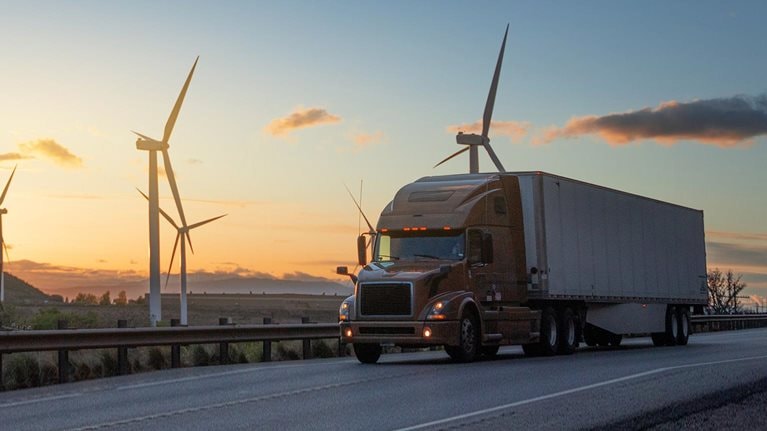Over the past decade, China has experienced an infrastructure boom and mushrooming demand for road transportation, leading to rapid growth of the heavy-duty-truck (HDT) market. Sales of HDTs in China grew from 600,000 vehicles in 2015 to a peak of 1.6 million in 2020. Then, in 2022, the HDT market in China went into a slump; a regional economic slowdown, COVID-19 lockdowns, and the fact that many customers prepurchased HDTs in 2020 and 2021 resulted in a sales volume of only 700,000 vehicles in 2022 (Exhibit 1).1
This slump is unlikely to be permanent. Given the size and resilience of the country’s economy, we expect the Chinese HDT industry to rebound and retain a significant and stable commercial base. That said, the rapid development of the past decade will be difficult to replicate.

As of 2022, the top five participants in China’s HDT market held more than 80 percent of the market—and the industry is becoming more concentrated.2 As demand normalizes after the boom, the established leaders will likely maintain their positions at the top of the market, but competitors from other geographies and adjacent sectors—including, for example, OEMs that formerly specialized in electric passenger vehicles—are likely to continue to jostle for position. Another example is that some global OEMs are already investing in the market, localizing their manufacturing by forming or acquiring Chinese companies to reduce costs and meet specific needs of local customers.
Four trends that will shape the next era for Chinese heavy-duty trucks
To support manufacturers’ quest for short-term sales and long-term growth, we have identified four of the most notable trends that will likely shape the Chinese HDT industry in 2030 and beyond: premiumization (the move toward subpremium and premium HDTs), electrification, autonomous driving, and a value pool shift to solutions and services. Players who capture the opportunities afforded by these trends could gain momentum and expand their profit pools, even in the face of increasing competition.
Premiumization
As customer mixes and demand continue to evolve, market shifts are spurring higher adoption of subpremium and premium HDTs. This will require manufacturers to explore greater reliability, comfort, and intelligence in their offerings.
We project that the market share of HDTs priced at more than $60,000 will reach 30 percent by 2030, up from 10 percent in 2020 (Exhibit 2).

Other than economic growth (which is likely to boost demand), several factors suggest HDT customers are increasingly interested in premiumization—or higher-end offerings in terms of price point, performance, and features. For instance, HDTs’ customer mix is changing. As the market matures and the Chinese logistics industry specializes and scales up, we expect a greater share of HDT sales to go to specialized-fleet customers, which have their own professional fleets, or fleet operation platforms. Indeed, we estimate that by 2030, 45 to 50 percent of HDT demand will come from midsize and large fleets, an increase of up to 20 percentage points compared with 2020 (Exhibit 3).

To maximize revenue, fleet customers prioritize fleet uptime and efficiency, which requires HDTs to perform better and to be more reliable. And with operating-cost controls designed to reduce the total cost of ownership and improve the ROI of fleet operations, demand for solutions and services related to life cycle cost-efficiency has increased.
We’ve observed that drivers have become younger, and many are used to higher standards. In response, trucks will need to become smarter and more comfortable, incorporating advanced technologies such as advanced driver assistance systems. The industry may also be subject to higher standards for emissions and safety as regulations continue to evolve. These factors are likely to boost sales of trucks with higher-end features—and prices.
Electrification
As technology and infrastructure mature, electric HDTs will grow rapidly in popularity over the next ten to 15 years and will be used in various applications, driving electrification in the entire HDT ecosystem.
For now, trucks with internal-combustion engines (ICE) dominate HDT road transportation, including long-haul, short-haul, and local or urban deliveries. But electrification will become increasingly central to road transportation as the total cost of ownership for electric HDTs becomes competitive with that of ICE HDTs, thanks to maturing technology and infrastructure. Our analysis suggests that electric HDTs will dominate the HDT market by 2040, with a boom in sales starting in 2030 (Exhibit 4)

Because of the difficulties presented by charging in long-haul trucking, these vehicles may be slower to electrify than others (for more, see sidebar, “Powertrain technologies in heavy-duty trucks”). But long-haul trucking is not the only application in which electrification can be stymied by charging concerns. Charging solutions are already emerging, including overnight slow charging, highway fast charging, hybrid charging, and battery swapping.
A significant amount of capital—from fleet operators, governments, and providers of charging services—may be required to meaningfully improve the accessibility of charging infrastructure. With better accessibility, OEMs could use smaller batteries on trucks, reducing batteries’ price and weight. Other efforts, such as combining battery swapping and autonomous driving in some settings, such as mines and ports, could improve vehicle use and reduce overall operating costs, creating better economics and faster commercialization.
In this environment, the charging industry in China is expanding (Exhibit 5).

The charging ecosystem is bolstered by digital platforms that connect upstream and downstream stakeholders and make it easier for charging companies to explore commercial opportunities. Charging-solution providers could diversify their service portfolios to include charging and swapping solutions tailored to different fleet management needs or delivery scenarios. They could also diversify their services at charging points and explore new business models, such as batteries as a service (BaaS).
Autonomous driving
As more use cases are identified, automation, particularly high-level autonomous driving, may see quicker adoption across the HDT industry.
Fully autonomous HDTs may be feasible in the long term if the technology advances significantly and stakeholders throughout the ecosystem collaborate to make it viable. In the nearer term, our analysis suggests that autonomous trucking operations in some use cases, such as point-to-point transportation on closed highways, may be commercialized around 2030.
Autonomous driving could help trucking operations become more cost-effective. Autonomous trucks will have higher up-front costs than their ICE counterparts, but our analysis suggests that they could reach cost parity within three years of ownership. Autonomous driving has at least six cost-saving benefits:
1. Improved quality of life for drivers and decreased driver-related costs. Autonomous driving could boost drivers’ quality of life by reducing the mental load of driving. This could lower the cost of attrition, a component of driver-related costs and one of the largest cost items for fleet operators.
2. Increased asset utilization. Autonomous trucks are not constrained by a driver’s hours of service and can reach higher utilization rates as a result. The higher uptime and reliability may boost the business case for premium HDTs.
3. Fuel and energy economy. Autonomous vehicles could make decisions that maximize energy efficiency during travel, acceleration, and braking.
4. Safety. As autonomous-driving technologies mature, self-driving trucks could incur fewer repair costs than traditional trucks because the number of accidents might fall.
5. Insurance costs. Our research suggests that insurance rates for self-driving cars may be significantly lower than for standard vehicles. This could result in significant savings for fleets of all sizes.
6. Vehicle maintenance. Driverless trucks can save on maintenance costs by reducing wear and tear from harsh driving practices such as rapid acceleration and hard braking.
Some OEMs have gotten a head start in commercializing autonomous driving. A large commercial-vehicle OEM already plans to launch an autonomous-driving product for point-to-point transportation on highways, with production slated to start after 2025.
Vehicle-to-infrastructure technology can help autonomous HDTs get market traction in China by lowering the price of autonomous vehicles. The technology requires sensors and integrated circuits to be part of road infrastructure and cloud platforms, which shifts this hardware—and the associated cost—away from autonomous vehicles. The technology also offers more computing power than a single vehicle can provide and extends sensors’ coverage.
Value pool shift to solutions and services
As competition increases and new-vehicle sales become less profitable, the core value pool of the Chinese HDT industry is shifting to solutions and services. Indeed, stakeholders throughout the industry have launched a few critical use cases and value-creation initiatives enabled by big data for HDTs. Our analysis suggests that the overall market size of HDT solutions and services in China may grow from $32 billion in 2021 to $69 billion in 2030, even if the growth of new-vehicle sales is relatively flat (Exhibit 6).

Although traditional aftermarket services are expected to remain significant in 2030, our analysis suggests that at almost 60 percent of the entire market, emerging businesses, especially battery charging and swapping, will grow significantly in the next decade. Our analysis also suggests that connectivity and autonomous-driving services may boom by 2030.
Solutions and services are already emerging in all three categories. Enhanced connectivity allows for customized services and subscription-based business models such as over-the-air software updates. Smart cockpits enabled by connectivity could be essential for fleet management services, including truckload surveillance, driver monitoring, and remote vehicle diagnosis.
Once they’re refined enough for most use cases, autonomous-driving technologies may boost demand not only for hardware such as chips and sensors but, more importantly, also for associated algorithms and solutions. These technologies may also allow stakeholders to experiment with and launch new business models such as capacity as a service.
Enabled by smart cockpit and connectivity functions, en route services for end customers and solutions such as parking, charging, and battery swapping are likely to be another focus area for energy companies and OEMs. BaaS is another one, thanks to comprehensive battery information management. At the same time, both public- and private-sector stakeholders could use transportation data sets to optimize investments in transport infrastructure, urban delivery, operations management, and network planning.
Finally, ecosystem stakeholders could use vehicle data in after-sales applications to optimize the customer experience. Predictive maintenance can help minimize fleets’ life cycle costs, improve aftermarket workshops and dealers’ layout and inventory, and maximize service efficiency.
Despite recent fluctuations, the Chinese HDT market will remain globally significant. We expect new opportunities to arise in the market driven by premiumization, electrification, autonomous driving, and a value pool shift to solutions and services. The future of the industry belongs to stakeholders that understand those trends well, customize their products and services accordingly, and build differentiating competences.

